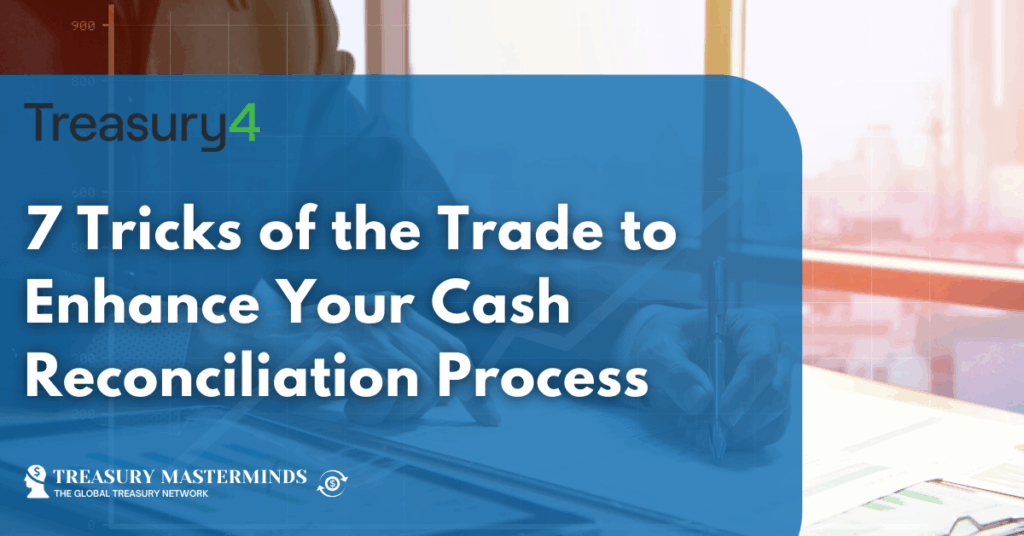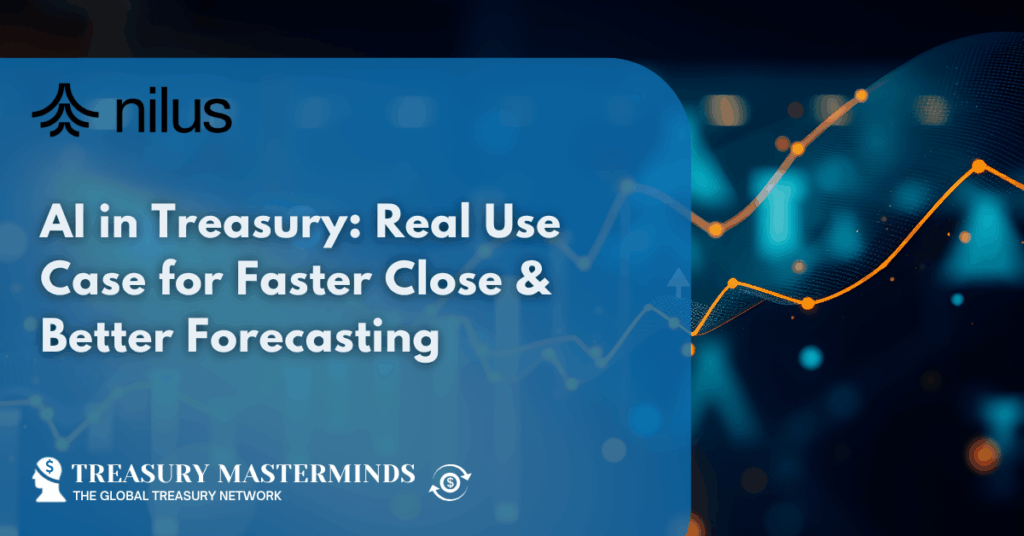
7 Tricks of the Trade to Enhance Your Cash Reconciliation Process
This article is written by Treasury4 Treasury professionals know that cash reconciliation is an essential part of cash flow management for any organization. It shows the company’s cash position, identifies errors or fraud, and allows management to make informed, strategic decisions based on the most up-to-date information. Unfortunately, the cash reconciliation process comes with several common hurdles that CFOs and treasurers must constantly deal with. And if you’re not careful, these issues can quickly snowball into larger financial risks. Today, we’ll share several actionable tips to improve your cash reconciliation process. First, let’s look at the most common pain points of the cash reconciliation process—and how they can create even larger problems. Key Challenges in Cash Reconciliation Cash reconciliation is the process of making sure your company’s financial records match up with actual bank balances. And it can come with several challenges, including: The good news is that there are strategies to overcome these challenges. Let’s look at some of the most effective ones. 1. Use Automation Automating your cash reconciliation is one of the most effective ways to optimize the process. It minimizes the manual workload, reduces errors, and accelerates the entire workflow. Here’s how automation can transform your process: Treasury4’s automation features provide near real-time visibility into your cash position, ensuring better accuracy and freeing up your finance team to focus on more important duties. Scalability is another key feature of Treasury4. As your business grows, so do your financial transactions. With a scalable solution, your reconciliation process evolves effortlessly—and automatically—alongside your operations. 2. Create Clear Guidelines Inconsistent practices across departments can lead to confusion and errors in your reconciliation process. Consider creating a step-by-step guide that clearly defines the reconciliation process. Include which systems to use, how to verify transactions, and how to resolve discrepancies. Make sure this guide is used by any team member involved in the process. Treasury4 can help standardize your cash reconciliation process by enabling custom workflows so that everyone follows the same procedures. Having a structured, repeatable process ensures consistency and reduces the risk of errors or discrepancies. 3. Use Templates to Ensure Nothing Is Overlooked Using standardized templates for various parts of the reconciliation process ensures every step is being carried out properly. Types of templates to consider: Treasury4’s customizable templates allow you to create tailored solutions for your organization’s unique needs, ensuring every task is completed to satisfaction. 4. Move to Daily or Weekly Reconciliations Monthly reconciliations can create a backlog of discrepancies that pile up over time. By moving to daily or weekly reconciliations, you can catch errors early and resolve them before they grow into larger issues. Keeping your accounts reconciled more often reduces stress (and bottlenecking) at the end of the month. Treasury4’s user-friendly interface improves the reconciliation process, making it easy to manage as often as you want. 5. Monitor Key Accounts Closely Not all accounts require the same level of attention. Make sure you give particular focus to accounts with high transaction volumes or frequent fluctuations. This way, you can make sure they’re reconciled accurately and efficiently. Treasury4 offers advanced reporting capabilities that allow you to set up custom alerts and track key accounts in real time. By watching these accounts closely, you can find issues before they escalate. Analyze Discrepancies and Trends to Refine Your Process Discrepancies will inevitably arise, but tracking and analyzing these issues over time can help you spot patterns, identify root causes, and implement preventive measures. Here are some best practices for analyzing discrepancies: With Treasury4’s detailed, customizable reporting features, finance teams can track discrepancies, show recurring issues, and gain valuable insights into their root causes. 6. Analyze Discrepancies and Trends to Refine Your Process Discrepancies will inevitably arise, but tracking and analyzing these issues over time can help you spot patterns, identify root causes, and implement preventive measures. Here are some best practices for analyzing discrepancies: With Treasury4’s detailed, customizable reporting features, finance teams can track discrepancies, show recurring issues, and gain valuable insights into their root causes. 7. Use Accurate Documentation to Simplify Audits Documenting every step of the reconciliation process is crucial—both for day-to-day operations and to be prepared for audits. For one thing, it enhances transparency and allows stakeholders to feel confident in the data. For another, properly documenting discrepancies—including their root causes and how they were resolved—makes audits more efficient and ensures compliance with regulatory requirements. Also Read Join our Treasury Community Treasury Masterminds is a community of professionals working in treasury management or those interested in learning more about various topics related to treasury management, including cash management, foreign exchange management, and payments. To register and connect with Treasury professionals, click [HERE] or fill out the form below. Notice: JavaScript is required for this content.

AI in Treasury: Real Use Case for Faster Close & Better Forecasting
This article is written by our partner, Nilus Treasury teams are under pressure like never before. Disconnected systems. Manual month‑end crunches. Limited visibility. Cash that could be put to work, sitting idle. At Techsommet’s Reimagining Treasury Management Summit 2025, we explored what happens when AI stops being a buzzword and starts being part of your treasury infrastructure. The conversation featured Flare, a fast‑growing company operating across 25+ bank accounts, multiple countries, and currencies, and how they moved from reactive, manual processes to real‑time visibility and forecasting in just three weeks. The Reality for Many Treasury Teams Before AI transformation, Flare’s treasury challenges were common across the industry: These challenges aren’t about talent; they’re about infrastructure. Without the right systems, treasury leaders spend their time fighting fires instead of shaping strategy. What AI‑Powered Treasury Looks Like When AI becomes part of the infrastructure, the workflow changes dramatically: 3 Lessons from This AI Transformation 1. Data chaos is the biggest blocker. AI success starts with clean, connected data.2. Explainable automation matters. AI should enhance, not replace, human judgment.3. Speed to value is critical. You don’t need a 12‑month rollout to see impact — Flare implemented in 3 weeks. Why This Matters for the Future of Treasury AI in treasury isn’t about replacing people, it’s about replacing outdated processes. When infrastructure enables real‑time visibility, automation frees teams to focus on strategic decisions, not month‑end firefighting. More from Nilus Join our Treasury Community Treasury Masterminds is a community of professionals working in treasury management or those interested in learning more about various topics related to treasury management, including cash management, foreign exchange management, and payments. To register and connect with Treasury professionals, click [HERE] or fill out the form below. Notice: JavaScript is required for this content.